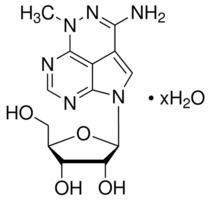CAS Number 35943-35-2 3D model (Jmol) Interactive image ChemSpider ID 58865 | Formula C13H16N6O4 Molar mass 320.12 g/mol | |
 | ||
Triciribine is a cancer drug which was first synthesized in the 1970s and studied clinically in the 1980s and 1990s without success. Following the discovery in the early 2000s that the drug would be effective against tumours with hyperactivated Akt, it is now again under consideration in a variety of cancers. As PTX-200, the drug is currently in two early stage clinical trials in breast cancer and ovarian cancer being conducted by the small molecule drug development company Prescient Therapeutics.
Contents
Background
Triciribine is a cell-permeable tricyclic nucleoside that inhibits the phosphorylation, activation, and signalling of all three family members of Akt - Akt-1, Akt-2 and Akt-3. These are serine/threonine protein kinases in the phosphoinositide 3-kinase (PI3K) signalling pathway that play a critical role in the regulation of cell proliferation and survival. Following recruitment of Akt to the plasma membrane, phosphorylation at threonine 308 and serine 473 (Akt-1 numbering) by PDK-1 or PDK-2 results in full activation of the enzyme. Triciribine does not inhibit PI3K or PDK1, the direct upstream activators of Akt, nor does it inhibit PKC, PKA, ERK1/2, serum- and glucocorticoid-inducible kinase, p38, STAT3, or JNK signalling pathways.
Early development, 1971-2004
Triciribine, first synthesized in 1971, was found to have definite anti-cancer properties and a phosphate ester of the drug went into clinical trials in the 1980s because it had improved solubility. The trials found the drug to be toxic with limited efficacy. For example, a Phase I study in 1984 evaluating 33 advanced cancer patients using a five-day continuous infusion schedule found hyperglycemia, hepatotoxicity, and thrombocytopenia as common toxicities with only one patient's cancer improving. A Phase II trial in 1993 found only two responders out of 21 cervical cancer patients. Triciribine was widely considered to be a failed cancer drug until its 'rehabilitation' in the early 2000s.
Development as an Akt inhibitor, 2004 -
In the early 2000s Said Sebti at the H. Lee Moffitt Cancer Center & Research Institute in Tampa, Fl and Jin Cheng at the University of South Florida established that Triciribine would be effective against tumours with hyperactivated AKT. By 2010 important parts of the mechanism of action for Triciribine had been elucidated, including its preventing AKT membrane translocation, and specifically its binding to the PH domain of AKT, thereby blocking its recruitment to the membrane, leading to subsequent inhibition of AKT phosphorylation.
Current development
As PTX-200, triciribine is currently in a Phase Ib/II study in breast cancer) and a Phase Ib trial in platinum resistant ovarian cancer.
